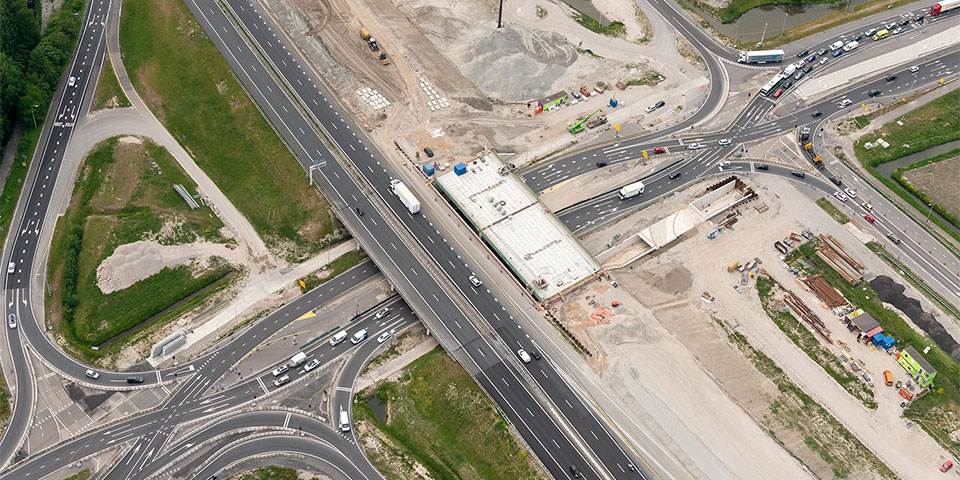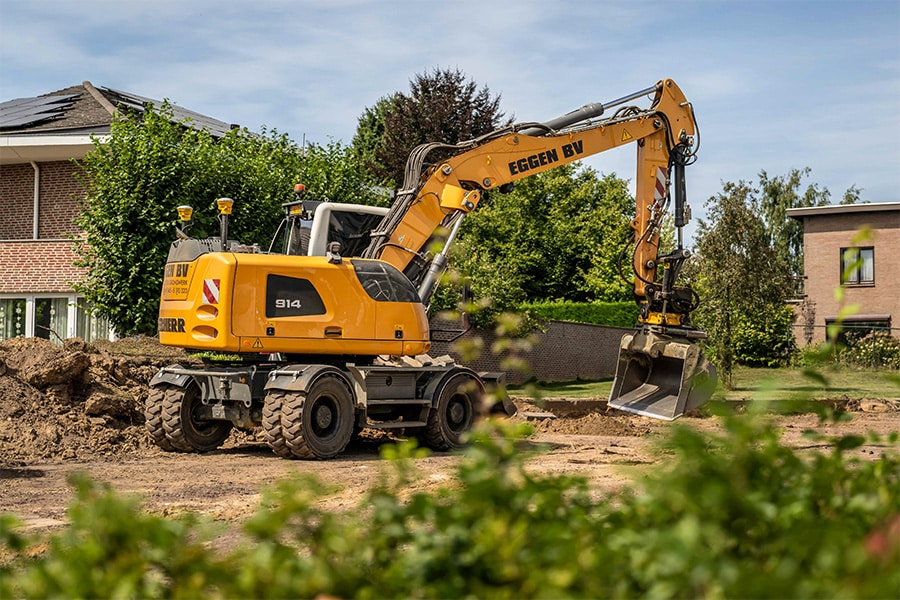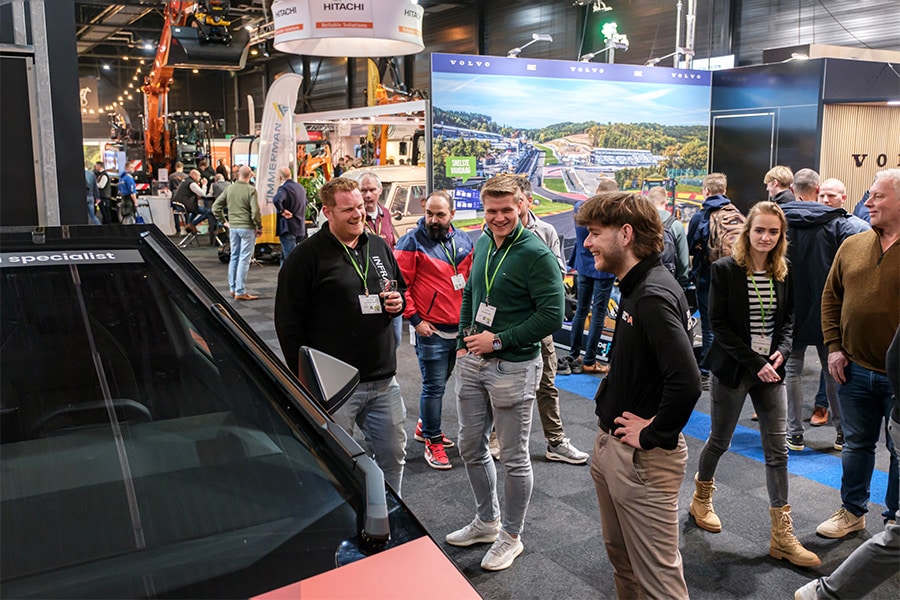
Diverging Diamond Interchange: a diamond of a (temporary) traffic solution
When it comes to innovative solutions, the Dutch infrastructure sector is big wholesaler. A good example of this can be found in the RijnlandRoute. Commissioned by the province of South Holland, construction consortium COMOL5 has applied a unique traffic solution there to keep the Leiden-West junction accessible during the work on the RijnlandRoute. During the work, a 'braided diamond connection', officially called the 'Diverging Diamond Interchange' (DDI), will be used.
At this temporary intersection (in the shape of a braided diamond), traffic will sort to the left earlier, driving on the left side of the road for a short length as a result. There will remain 2 x 2 lanes for motorized traffic. This temporary situation has been in use since May 2019 and will last approximately 2.5 years. The DDI is an American invention; its spiritual father is traffic engineer Gilbert Chlewicki, P.E. (professional engineer). He conceived of the DDI in 2000 and made a study of it. At a conference sponsored by the Transportation Research Board, he presented this high-profile idea in 2003. Today there are more than 200 DDIs across America.
A temporary measure that does its job superbly
We spoke with Angelo van Turenhout of MAPtm, Rianne van Vuren, Environmental Manager at Province of South Holland and Michel de Jong, Infrastructure Management Service at Province of South Holland. "The DDI emerged as a temporary solution in the tender phase. The Provincial Zoning Plan and the route decision for the RijnlandRoute had already been established." Van Turenhout adds, "The advantage of our proposed DDI is that better traffic flow could be achieved with less asphalt. Less space with maximum effect. It deserves kudos that the province of South Holland chose the DDI, as the first in the Netherlands. A great case to see if this idea can be emulated in the rest of the country."
According to De Jong, applying the DDI as a temporary solution is a good opportunity to gain experience with this intersection form. "It is easy for the road manager to assess its operation. The final situation will be constructed in accordance with the route decision, but what we learn about the functioning of the DDI gives us the tools to apply this concept elsewhere." Van Turenhout: "We are more than satisfied with its operation, applying the DDI elsewhere, in permanent situations, means 'doing more with less asphalt'. That fits brilliantly into the current views on sustainability. Moreover, you save an enormous amount of space, provided you can build from 'scratch'."
It took some getting used to, of course....
"The DDI has been in place for a year now," continues De Jong. "Obviously it took quite a bit of getting used to for the road users, but to our surprise, hardly any complaints have been received. The first intersections - including changing lanes - are regulated by traffic lights. That is a little tricky at first. You have to get in the right lane before the traffic lights. One situation motorists had to get used to, for example, is turning right in the direction of The Hague when coming from Katwijk. Traffic now has to turn right, whereas before it was always left. The challenge was made even more complex by the parallel lanes from Leiden and the fact that another intersection on the West side is close to the DDI. We enlisted the help of Arcadis to monitor and guide the traffic in this regard."

De Jong: "Obviously it took quite a bit of getting used to for road users, but to our surprise, hardly any complaints were received." (Image: Roelof de Vries)
Good communication is half the battle
In the first few weeks of opening, there was a lot of evaluation with the police, the road authority and the contractor. "Through good communication and consultation even before the opening, many problems were solved beforehand. Arriva had even distributed simulation videos to the bus drivers so they would be well prepared," Van Vuren says. Van Turenhout adds, "The fact that there were hardly any problems was partly due to the efforts of Soltegro, which virtually recreated the DDI and conducted tests with all stakeholders. The lines, the signs, the traffic lights, the road behavior of the vehicle ... really everything was included in the simulation. That gave us good insights based on which we were able to make the necessary adjustments."
"Among the groups invited to the virtual test was also a reflection of the average road user there," Van Vuren explains. "These people were invited via social media. And what turns out now that people are used to the situation? These very people are now our biggest ambassadors online! It couldn't be more beautiful, actually."
"You are turning onto the road here. Is that allowed?"
De Jong admits that in the beginning there were still fears of mistakes made by road users. "However, these mistakes were not made, much to our delight. We did see some turning movements, especially on the Leiden side." There are now official evaluation reports, covering a period of 3 months after the opening. Van Turenhout: "The adjustments we made to the DDI also took these evaluations into account. This has allowed us to optimize the VRI, based on changing figures."
Less is more
The three interlocutors see potential for the DDI in a final situation. "We see in practice that this is a perfect learning experience. It definitely tastes like more. We learned a lot that we can take into account in future DDIs. For example, we discovered the usefulness of barriers in the DDI, in the right place they ensure that traffic is not blinded by the headlights of the opposite, waiting traffic. We also reduced the number of lines on the road based on our experiences. Especially in bad weather, too many lines create a confusing situation. Less is more, more grip by fewer lines."
From day one in Google Maps
In conclusion, Van Turenhout says, "We made sure that the DDI was fully present in the major navigation applications from the day it opened. Google Maps, Waze, TomTom and Apple Maps are fully up to date. That makes it even easier to use the DDI comfortably."
Retrieved from www.rijnlandroute.nl/diamantaansluiting are simulation videos of several routes through the braided diamond connection Leiden-West.




